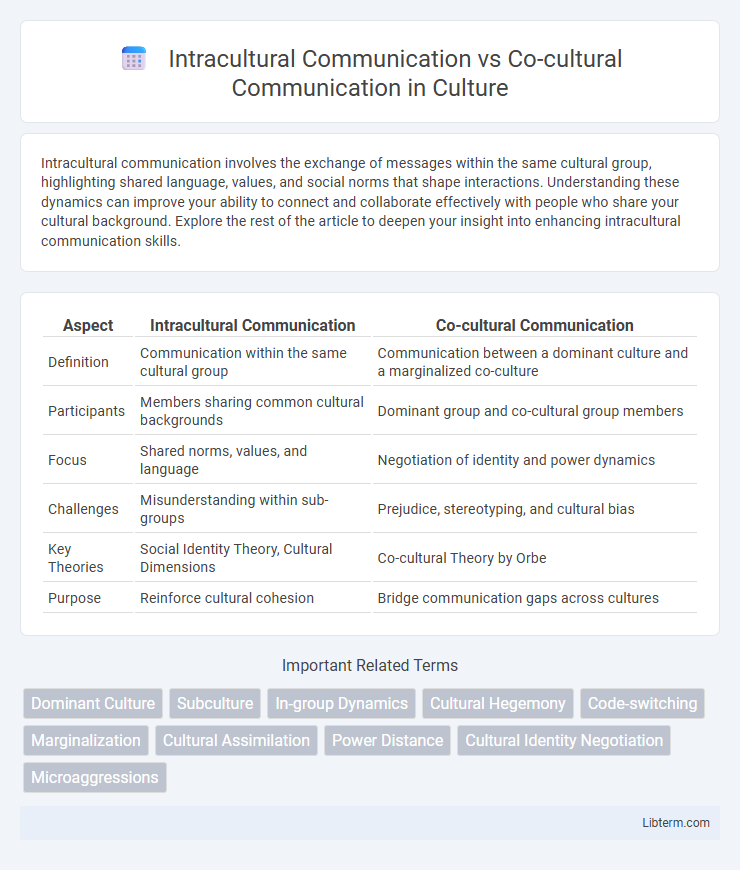Intracultural communication involves the exchange of messages within the same cultural group, highlighting shared language, values, and social norms that shape interactions. Understanding these dynamics can improve your ability to connect and collaborate effectively with people who share your cultural background. Explore the rest of the article to deepen your insight into enhancing intracultural communication skills.
Table of Comparison
| Aspect | Intracultural Communication | Co-cultural Communication |
|---|---|---|
| Definition | Communication within the same cultural group | Communication between a dominant culture and a marginalized co-culture |
| Participants | Members sharing common cultural backgrounds | Dominant group and co-cultural group members |
| Focus | Shared norms, values, and language | Negotiation of identity and power dynamics |
| Challenges | Misunderstanding within sub-groups | Prejudice, stereotyping, and cultural bias |
| Key Theories | Social Identity Theory, Cultural Dimensions | Co-cultural Theory by Orbe |
| Purpose | Reinforce cultural cohesion | Bridge communication gaps across cultures |
Understanding Intracultural Communication
Intracultural communication involves interactions within members of the same cultural group, emphasizing shared values, beliefs, and norms that influence communication patterns. Understanding intracultural communication requires recognizing how language, customs, and social roles shape the way messages are encoded and decoded among individuals who share a cultural identity. This focus enhances effective communication by reducing misunderstandings and fostering deeper connections within homogeneous cultural settings.
Defining Co-cultural Communication
Co-cultural communication refers to the interaction between groups that exist within a dominant culture but possess distinct cultural identities, often shaped by factors such as ethnicity, gender, or social class. It emphasizes how marginalized or non-dominant groups communicate within the broader societal context to navigate power dynamics and assert their identities. Unlike intracultural communication, which occurs within the same cultural group, co-cultural communication highlights the complexities and strategies used by minority groups to engage in dialogue with dominant cultural norms.
Key Differences Between Intracultural and Co-cultural Communication
Intracultural communication occurs within a single cultural group, emphasizing shared norms, values, and language, which facilitates mutual understanding and cohesive interactions. Co-cultural communication involves interactions between dominant and non-dominant cultural groups within a broader society, highlighting power dynamics and strategies marginalized groups use to navigate communication. Key differences include the scope of cultural groups involved--intracultural is within one culture, while co-cultural bridges multiple cultures--and the influence of social hierarchy on communication styles and adaptation processes.
The Role of Cultural Backgrounds in Communication
Cultural backgrounds significantly shape both intracultural and co-cultural communication by influencing individuals' values, norms, and communication styles within their own cultural groups or between dominant and marginalized groups. Intracultural communication involves shared cultural codes that facilitate mutual understanding, while co-cultural communication requires navigating power dynamics and negotiating identity across different cultural contexts. Understanding these roles helps improve intercultural competence and reduces miscommunication in diverse social interactions.
Communication Strategies Within Dominant Cultures
Communication strategies within dominant cultures often emphasize assertiveness, clarity, and maintaining social hierarchy in intracultural communication, where members share common cultural backgrounds and norms. In contrast, co-cultural communication strategies involve code-switching, nonverbal cues, and identity negotiation as members of marginalized or non-dominant groups interact with dominant cultural norms. Effective use of accommodation, non-assertive, assertive, and aggressive communication approaches enables co-cultural members to navigate power dynamics and enhance mutual understanding.
Navigating Power Dynamics in Co-cultural Interactions
Navigating power dynamics in co-cultural communication requires understanding how individuals from marginalized groups interact with dominant societal structures, often adapting their communication styles for social acceptance or resistance. Intracultural communication occurs within a single culture and assumes relatively equal power relations, whereas co-cultural communication centers on interactions between groups with unequal power, emphasizing strategies like accommodation, separation, or assimilation. Recognizing these dynamics enhances effective communication by addressing issues of identity, privilege, and social hierarchy in diverse environments.
Common Barriers in Intracultural and Co-cultural Communication
Common barriers in intracultural communication include language variations, regional dialects, and differing social norms within the same cultural group, leading to misunderstandings despite shared national or ethnic backgrounds. In co-cultural communication, barriers often stem from power imbalances, stereotypes, and lack of representation affecting marginalized groups interacting with dominant cultures. Both contexts face challenges such as ethnocentrism and nonverbal misinterpretations, which hinder effective message exchange and relationship building.
Real-life Examples of Intracultural and Co-cultural Communication
Intracultural communication takes place within the same cultural group, such as conversations among family members using shared language and customs during a traditional holiday celebration. Co-cultural communication occurs between individuals from different cultural backgrounds within a larger societal context, exemplified by a workplace team consisting of members from diverse ethnicities collaborating on a project. Understanding dynamics in both scenarios enhances effective interaction by acknowledging cultural nuances and identities influencing communication patterns.
Importance of Awareness and Adaptation
Awareness and adaptation play crucial roles in intracultural and co-cultural communication by enhancing mutual understanding and reducing misunderstandings within and between cultural groups. Intracultural communication requires sensitivity to subtle nuances and shared norms within a single culture, while co-cultural communication demands an acute awareness of power dynamics and varied cultural perspectives in diverse social contexts. Mastering these skills fosters inclusive dialogue, promotes effective interaction, and supports the development of culturally competent communication strategies.
Enhancing Effective Communication Across Cultural Contexts
Intracultural communication involves interactions within a single cultural group, emphasizing shared traditions, values, and language nuances that promote deeper understanding. Co-cultural communication occurs between different cultural groups, requiring the navigation of diverse perspectives, power dynamics, and identity factors to achieve mutual respect. Enhancing effective communication across these contexts relies on cultural competence, empathy, and the ability to adapt communication styles to reduce misunderstandings and foster inclusive dialogue.
Intracultural Communication Infographic

 libterm.com
libterm.com